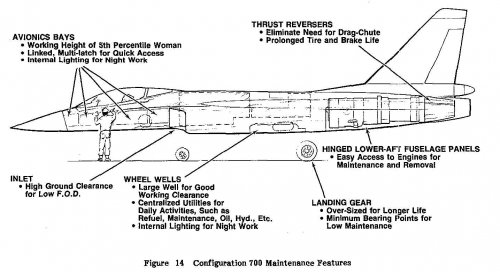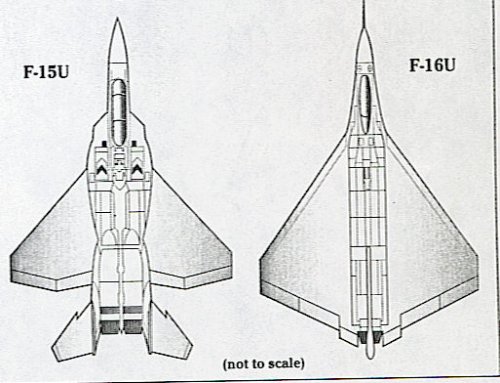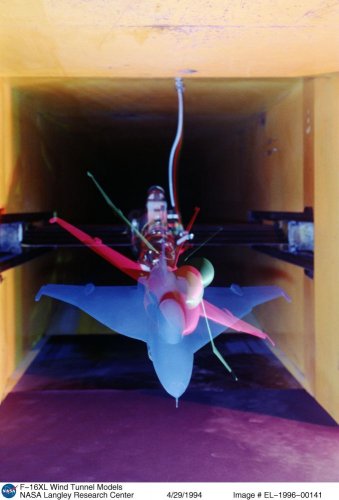You are using an out of date browser. It may not display this or other websites correctly.
You should upgrade or use an alternative browser.
You should upgrade or use an alternative browser.
Delta wing F-16s: SCAMP, F-16XL, Falcon 21 and more
- Thread starter flateric
- Start date
- Joined
- 3 January 2006
- Messages
- 1,118
- Reaction score
- 738
Flateric, do you have any weight numbers for this design? This thing is the size of a Rafale or Hornet, but it has the wing area of a F-15.
I would also have to wonder about the engine choice. Judging by the date of the project and the drawings, I would guess that the PW-1120 or the F-404 might have been baseline powerplants.
I would also have to wonder about the engine choice. Judging by the date of the project and the drawings, I would guess that the PW-1120 or the F-404 might have been baseline powerplants.
Matej
Multiuniversal creator
TinWing said:I have seen a drawing of a proposed F-16 derivative with a similar trapezoidal wing planform - although it dates from 5 years later.
Thats it. F-16U - one of early proposals for Saudi Arabia.
Attachments
- Joined
- 8 January 2006
- Messages
- 1,605
- Reaction score
- 734
Per one of the aerodynamicists who worked on it, the F-16U's wing has the planform of the YF/F-22's wing. As near as I can tell, the YF-22 wing mated to the F-2 fuselage, which was derived from the earlier "Agile Falcon" aerodynamic studies, comes quite close to this.
- Joined
- 27 December 2005
- Messages
- 17,018
- Reaction score
- 22,230
- Joined
- 27 December 2005
- Messages
- 17,018
- Reaction score
- 22,230
Matej
Multiuniversal creator
This first design is very nice 
- Joined
- 27 December 2005
- Messages
- 17,018
- Reaction score
- 22,230
Source:
Jay Miller Aerograph 1 General Dynamics F-16 Fighting Falcon Aerofax 1982
Jay Miller Aerograph 1 General Dynamics F-16 Fighting Falcon Aerofax 1982
- Joined
- 27 December 2005
- Messages
- 17,018
- Reaction score
- 22,230
- Joined
- 8 January 2006
- Messages
- 1,605
- Reaction score
- 734
I think "F-16XL-2" shows the version I always liked, they used a standard F-16 horizontal tail as an all-moving vertical tail above the basic fairing. I seem to remember a three-view of that version in an old issue of Aviation Week.
Looks like NASA is thinking of putting F-16XL #1, the single-seater, back in the air to support sonic boom research. Fingers crossed...
 www.fbo.gov
www.fbo.gov
FBO.gov has moved
- Joined
- 8 January 2006
- Messages
- 1,605
- Reaction score
- 734
Jeb said:To me, this is one of the biggest "what could have been" projects ever.
Well, according to folk I work with who were there at the time, it did have its problems. Apparently the cg was such that ground handling, and stability, was a right handful for the pilot.
- Joined
- 22 October 2006
- Messages
- 338
- Reaction score
- 75
According to the reports the laminar boundary layer goals were not reachable, the plane did not supercruise efficiently.
But maybe a new version would have fix this problem.
But maybe a new version would have fix this problem.
- Joined
- 27 December 2005
- Messages
- 17,018
- Reaction score
- 22,230
F-16U info from Interavia
In principle, the F-16U is a return to the F-16XL, which General Dynamics demonstrated in 1983. In both cases, the goal is to increase the F-16's range by adding internal fuel and decreasing the drag of external weapons.
The F-16U has a 1.4m fuselage stretch and a 65 sq m cropped-delta wing. The plan-form, large-area leading-edge flaps and twist and camber draw on F-22 experience, but the structure (aluminium alloy ribs and spars and composite skins) is different. The wing is bigger in span and area and deeper in section than that of the XL and, together with the fuselage stretch, increases internal fuel capacity to more than 7200kg - well over twice that of the F-16C. Wing root troughs hold four AIM-120s, and underwing hard-points can carry four 970kg weapons or eight 450kg weapons in addition to a pair of AIM-9s. Sweep angles are selected to reduce radar cross-section (RCS).
Rough calculations suggest that the fully loaded F-16U has about the same fuel fraction as an F-15E with the same weapon load and a centreline fuel tank. The F-16U has lower-drag AIM-120 carriage, no LANTIRN pods and no external fuel, so Lockheed Martin claims of equal or better range should not be dismissed.
The F-16U will be about 25% heavier than the F-16C but should turn better, even with the current 129kN versions of the F110 and F100, because of the larger wing. The F-16U is also designed to be more stable at high angles of attack.
A more powerful engine, however, is very desirable to restore acceleration. In August, General Electric plans to run a 155kN F110 demonstrator with a higher-airflow blisk fan based on F120 technology, matched to the F-16's inlet, and fitted with a scaled-up version of the F414's composite-lined augmentor. Pratt & Whitney may offer its F100-PW-229 Plus.
Lockheed Martin also believes that GE's Multi-Axis Thrust Vectoring (MATV) nozzle, tested on an F-16 last year, is mature enough to be offered on the F-16U, expanding its low-speed agility and flight envelope.
As proposed to the UAE, the F-16U will have a two-seat forward fuselage. Two-seaters will be needed for training and for some operational missions, and delivering all aircraft with the same external configuration saves development costs. The cockpit will be similar to the MLU, but with an added central MFD and LCD back-up flight instruments like those of the YF-22.
If its bid is successful, Lockheed Martin plans to spread the entire cost of development over the UAE's 80-aircraft order. The company believes that the difference in both acquisition and operating cost between the F-16C and the F-15E is so large that the F-16U can compete, even with a development bill (probably in eight digits) attached to each aircraft.
XP67_Moonbat
ACCESS: Top Secret
- Joined
- 16 January 2008
- Messages
- 2,262
- Reaction score
- 470
Man! I had something just like this in one of my notebooks! Here I thought I was being innovative. :'( Ah well.
NASA has reserved the designation X-54 for a low boom supersonic demonstrator.
Modification of the F-16XL either the single-seat Ship 1 or two-seat Ship 2 owned by NASA,
is identified as the most cost effective option.
Boeing's proposal would modify the single-seat F-16XL-1's nose, canopy and tail to reshape
the aircraft's shockwave signature.
This aircraft will complement the results of the F-5SBD, NASA F-15B "Quiet Spike" and the
F-15B equipped with canard foreplanes, for which NASA investigated the effects on sonic boom
signature of changing longitudinal lift distribution and nozzle area ratio.
All these studies for a fourth generation of commercial SST with low boom, to fly over land at
supersonic speeds.
Modification of the F-16XL either the single-seat Ship 1 or two-seat Ship 2 owned by NASA,
is identified as the most cost effective option.
Boeing's proposal would modify the single-seat F-16XL-1's nose, canopy and tail to reshape
the aircraft's shockwave signature.
This aircraft will complement the results of the F-5SBD, NASA F-15B "Quiet Spike" and the
F-15B equipped with canard foreplanes, for which NASA investigated the effects on sonic boom
signature of changing longitudinal lift distribution and nozzle area ratio.
All these studies for a fourth generation of commercial SST with low boom, to fly over land at
supersonic speeds.
- Joined
- 4 May 2008
- Messages
- 2,439
- Reaction score
- 739
I saw the two gutted airframes of the XLs in a hangar at Dryden some three years ago. The engines weren't there, IIRC, and the airframes looked very forlorn all covered in dust, with some non-structural appendages missing.
- Joined
- 27 December 2005
- Messages
- 17,018
- Reaction score
- 22,230
Merged topics.
Flight 3 view of Falcon 21
http://www.flightglobal.com/pdfarchive/view/1990/1990%20-%202658.html
Flight 3 view of Falcon 21
http://www.flightglobal.com/pdfarchive/view/1990/1990%20-%202658.html
- Joined
- 27 December 2005
- Messages
- 17,018
- Reaction score
- 22,230
Some great images
Attachments
-
 img_57_6900_4.jpeg176.2 KB · Views: 872
img_57_6900_4.jpeg176.2 KB · Views: 872 -
 img_57_6900_3.jpeg240.7 KB · Views: 692
img_57_6900_3.jpeg240.7 KB · Views: 692 -
 img_57_6900_0.jpeg190.5 KB · Views: 739
img_57_6900_0.jpeg190.5 KB · Views: 739 -
 F-16XL_parked_high_angle_view.jpg195.6 KB · Views: 821
F-16XL_parked_high_angle_view.jpg195.6 KB · Views: 821 -
 F-16XL_loaded_with_500lb_bombs.jpg299 KB · Views: 816
F-16XL_loaded_with_500lb_bombs.jpg299 KB · Views: 816 -
 060905-F-1234S-050.jpg262 KB · Views: 942
060905-F-1234S-050.jpg262 KB · Views: 942 -
 060905-F-1234S-049.jpg381.5 KB · Views: 702
060905-F-1234S-049.jpg381.5 KB · Views: 702 -
 060905-F-1234S-051.jpg285.4 KB · Views: 840
060905-F-1234S-051.jpg285.4 KB · Views: 840
- Joined
- 27 December 2005
- Messages
- 17,018
- Reaction score
- 22,230
more
Attachments
-
 img_57_6900_12.jpeg151.4 KB · Views: 569
img_57_6900_12.jpeg151.4 KB · Views: 569 -
 img_57_6900_11.jpeg148.8 KB · Views: 565
img_57_6900_11.jpeg148.8 KB · Views: 565 -
 img_57_6900_10.jpeg231.1 KB · Views: 614
img_57_6900_10.jpeg231.1 KB · Views: 614 -
 img_57_6900_9.jpeg159.5 KB · Views: 582
img_57_6900_9.jpeg159.5 KB · Views: 582 -
 img_57_6900_8.jpeg87.4 KB · Views: 577
img_57_6900_8.jpeg87.4 KB · Views: 577 -
 img_57_6900_7.jpeg139.3 KB · Views: 581
img_57_6900_7.jpeg139.3 KB · Views: 581 -
 img_57_6900_6.jpeg177.5 KB · Views: 558
img_57_6900_6.jpeg177.5 KB · Views: 558 -
 img_57_6901_0.jpeg172.5 KB · Views: 661
img_57_6901_0.jpeg172.5 KB · Views: 661
- Joined
- 27 December 2005
- Messages
- 17,018
- Reaction score
- 22,230
Demon Lord Razgriz
ACCESS: Confidential
- Joined
- 31 October 2008
- Messages
- 188
- Reaction score
- 12
vajt said:What a great looking aircraft. Too bad it was never put into production. Imagine a hi-lo mix of F16-XLs with F-23s!
-----JT-----
Ace Combat Zero, Wizard Squadron :
Anywho, wasn't there a tailless variant of the F-16XL?
- Joined
- 2 August 2006
- Messages
- 3,215
- Reaction score
- 1,352
Demon Lord Razgriz said:Anywho, wasn't there a tailless variant of the F-16XL?
The tailless F-16XL is shown in one of the tailless aircraft design threads.
It seems like this planform is a huge missed opportunity. anyone hvae any info. on why it hasn't been incorporated into any new design? It seems like it would have been perfect for CALF/JAST/JSF because of the long range. Instead neither of the 3 major designs used it. How does it fare in terms of LO? From what I know the F-16XL had great performance with this wing.
- Joined
- 2 August 2006
- Messages
- 3,215
- Reaction score
- 1,352
It had great super-cruise performance, however, there are other factors, such as maneuvering requirements, that have to be taken into account, among many others. If you look at some of the many threads here on the CALF-MRF-JAST-JSF designs, you will see design/testing charts of various configuration looked at including the cranked arrow wing. The simple fact is, for the given requirements it just wasn't the best choice.
It's also my understanding that the F-16XL had some cg problems and also weapons release problems with the AIM-7's located under the wing roots. Of course, that doesn't mean they weren't correctable, I'm just pointing that out. However, what I thought was silly was having the F-16XL compete with the F-15E for a strike aircraft package. As if we didn't know how that would turn out. Besides, the F-16 is usually used for bombing/attack missions anyway, so I still think the USAF should have just switched over to the XL. Not to mention, it probably would have made a better interceptor for the ANG, since speed and range are more important for that mission than maneuverability.
But it didn't go into production, so now we have F-16's with CFT's to get the range, but with a more brutish aesthetic. OK, we don't have them, but other countries do.
It's also my understanding that the F-16XL had some cg problems and also weapons release problems with the AIM-7's located under the wing roots. Of course, that doesn't mean they weren't correctable, I'm just pointing that out. However, what I thought was silly was having the F-16XL compete with the F-15E for a strike aircraft package. As if we didn't know how that would turn out. Besides, the F-16 is usually used for bombing/attack missions anyway, so I still think the USAF should have just switched over to the XL. Not to mention, it probably would have made a better interceptor for the ANG, since speed and range are more important for that mission than maneuverability.
But it didn't go into production, so now we have F-16's with CFT's to get the range, but with a more brutish aesthetic. OK, we don't have them, but other countries do.
- Joined
- 3 June 2011
- Messages
- 17,928
- Reaction score
- 11,108
Sundog said:It had great super-cruise performance, however, there are other factors, such as maneuvering requirements,
Where did you hear it could cruise supersonically dry and was lacking in manueverability?
See attached:
Attachments
- Joined
- 18 March 2008
- Messages
- 3,529
- Reaction score
- 894
sferrin said:Where did you hear it could cruise supersonically dry
That's what it was designed for in the first place: F-16 SCAMP (Supersonic Cruise and Maneuver Prototype) later renamed F-16XL. The cranked delta wing was from all the work that went into supersonic commercial air travel...
- Joined
- 6 August 2007
- Messages
- 3,447
- Reaction score
- 3,898
Abraham Gubler said:sferrin said:Where did you hear it could cruise supersonically dry
That's what it was designed for in the first place: F-16 SCAMP (Supersonic Cruise and Maneuver Prototype) later renamed F-16XL. The cranked delta wing was from all the work that went into supersonic commercial air travel...
The two-seat XL supercruised with the F110 engine during it's time with NASA.
- Joined
- 3 June 2011
- Messages
- 17,928
- Reaction score
- 11,108
Abraham Gubler said:sferrin said:Where did you hear it could cruise supersonically dry
That's what it was designed for in the first place: F-16 SCAMP (Supersonic Cruise and Maneuver Prototype) later renamed F-16XL. The cranked delta wing was from all the work that went into supersonic commercial air travel...
Right, but I thought I'd read it's success was marginal at best there.
- Joined
- 2 August 2006
- Messages
- 3,215
- Reaction score
- 1,352
sferrin said:Sundog said:It had great super-cruise performance, however, there are other factors, such as maneuvering requirements,
Where did you hear it could cruise supersonically dry and was lacking in manueverability?
See attached:
Maneuverability is a relative term. I didn't say it wasn't maneuverable, I said in all metrics for modern fighter aircraft, maneuverability being one of them, the cranked arrow wing comes up short. If it was so much better than all of the others, you would have seen it on ATF designs and JSF designs, etc. The evidence speaks for itself.
Granted, it's also based on the mission requirements. But when it comes to what missions the U.S. military is designing for, the cranked arrow wing obviously wasn't right for the job. Now, maybe if the USAF goes for an all out Mach 2.8 supercruise aircraft, where the supercruise is the dominant part of the requirement, you might see it then.
As for supercruise, I've always heard the F-16XL with the GE engine was an excellent supercruise aircraft. Unfortunately, I haven't been able to find any data to back it up and nobody seems to be offering any, one way or the other.
- Joined
- 3 June 2011
- Messages
- 17,928
- Reaction score
- 11,108
Sundog said:sferrin said:Sundog said:It had great super-cruise performance, however, there are other factors, such as maneuvering requirements,
Where did you hear it could cruise supersonically dry and was lacking in manueverability?
See attached:
Maneuverability is a relative term. I didn't say it wasn't maneuverable, I said in all metrics for modern fighter aircraft, maneuverability being one of them, the cranked arrow wing comes up short. If it was so much better than all of the others, you would have seen it on ATF designs and JSF designs, etc. The evidence speaks for itself.
Did you look at the graphs? It blew the standard F-16 out of the water in the manueverability department. (Which is no small thing.) I suspect, with all of it's curves, if it came up short it would be in the area of RCS.
Similar threads
-
ADF to LWF: Evolution of the General Dynamics F-16
- Started by overscan (PaulMM)
- Replies: 135
-
Convair / General Dynamics Advanced Tactical Fighter (1965)
- Started by overscan (PaulMM)
- Replies: 15
-
ASD Preliminary Designs in Splendid Vision, Unswerving Purpose
- Started by XP67_Moonbat
- Replies: 16
-
-

























